9 things I wish I knew before starting Darkest Dungeon 2
How to keep stress low and build a better party in Darkest Dungeon 2, one of 2021's most grueling RPGs.
Darkest Dungeon was both infamous and beloved for its difficulty, taking the party system and lack of forgiveness from older RPGs and updating that formula with grimdark art and a unique combat system.
Darkest Dungeon 2 borrows many of the basics of the first game, but also introduces some new mechanics alongside a more traditional roguelike progression. Here’s a handful of Darkest Dungeon 2 tips that would have helped me reach the end of Early Access with fewer failed runs and a little less frustration over my neurotic, uncooperative little adventurers!
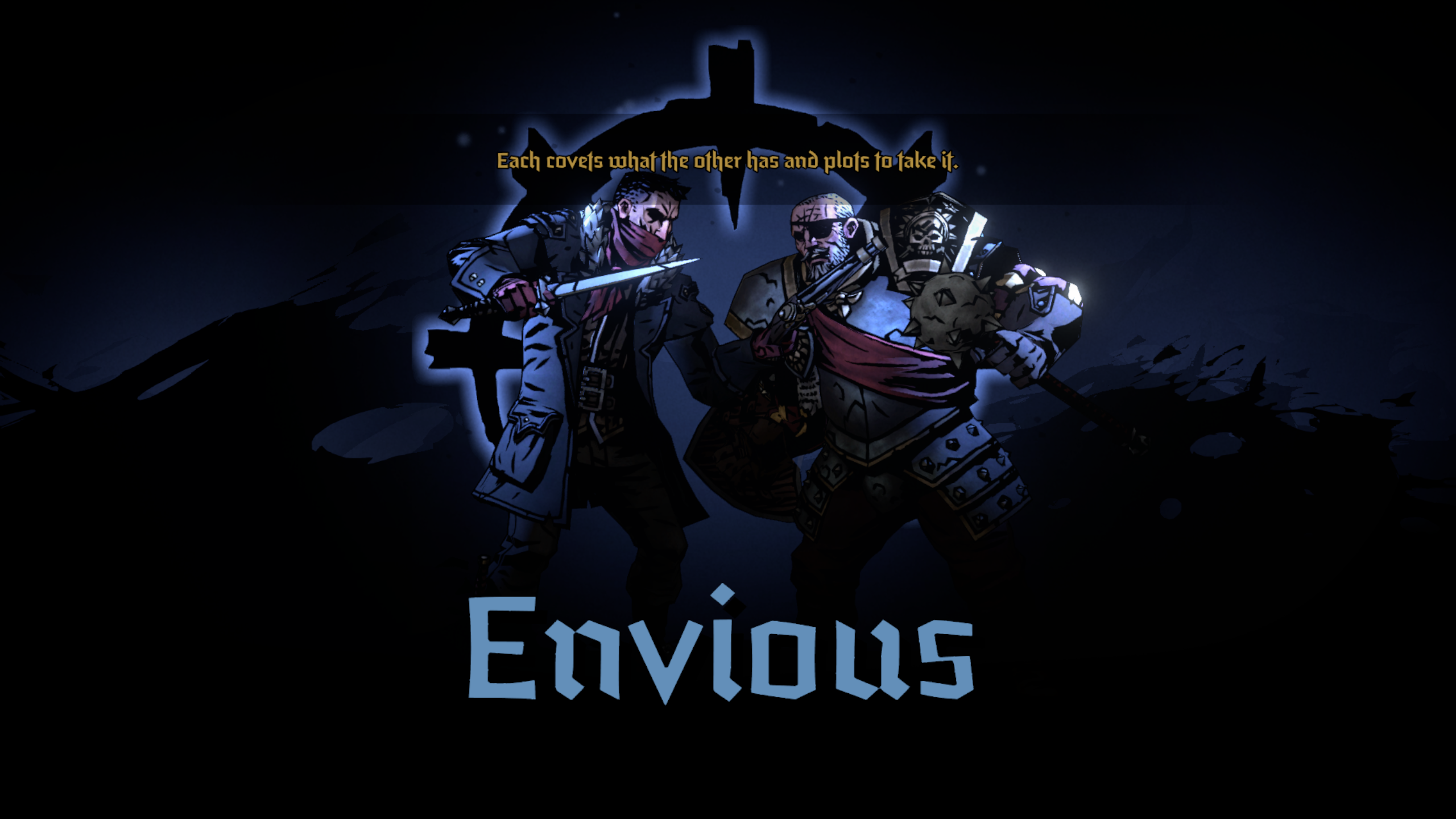
1. Don't fret about HP. Focus on stress.
What hasn't changed from the original Darkest Dungeon is that you'll want to aggressively reduce stress. Characters with higher stress (50% or higher, in my experience) seem to have a chance of negatively reacting to combat events. Managing stress is probably the most important thing to attend to in Darkest Dungeon 2. It's a much more important lifebar than your actual life.
Laudanum is one of the early common items that reduce stress, and I pick it up almost every time I have the opportunity. But probably the most reliable way of mitigating stress is with the Plague Doctor (see tip no. 7).
Healing is simply less of a problem in Darkest Dungeon 2 because your characters now heal HP incrementally and automatically as you travel forward on the cart. Persistent damage like bleeding and Blight also doesn't carry over to map travel when you exit combat.
Heroes build stress by taking damage, suffering status effects, and bickering with their companions. While health slowly regenerates as you travel between encounters, stress persists and even tends to rise as you go along. If you let a hero’s stress meter reach the boiling point, it spills over into a huge health loss while also damaging that hero’s relationship with the rest of their party. I highly recommend prioritizing stress-relieving abilities and consumables to finish your first run.
2. Relationships are everything
When it rains in Darkest Dungeon 2, it pours. Stress builds on stress snowballing into greater catastrophe, with one of the most important consequences being your party’s group dynamic. Combat actions, overt choices, and the ever-present RNG contribute to a relationship meter between each member of your party. When it maxes out, positive or negative, it forms a bond between the two heroes in question.
Keep up to date with the most important stories and the best deals, as picked by the PC Gamer team.
Positive relationships include “Amorous,” “Respectful,” or “Inseparable,” and contribute buffs, combat assists, and surprise heals, again mostly at the behest of RNG. They feel great. Some of the negative relationships are “Resentful,” “Tumultuous,” and “Hateful.” These result in negative status effects, as well as a high chance of stress gain between both parties. Positive relationships are fragile, whereas negative relationships are quite difficult to reverse. If you notice two heroes’ negative relationship meter getting high, it’s worth it to lower their stress levels and look for consumables to improve their affinity at the next inn.
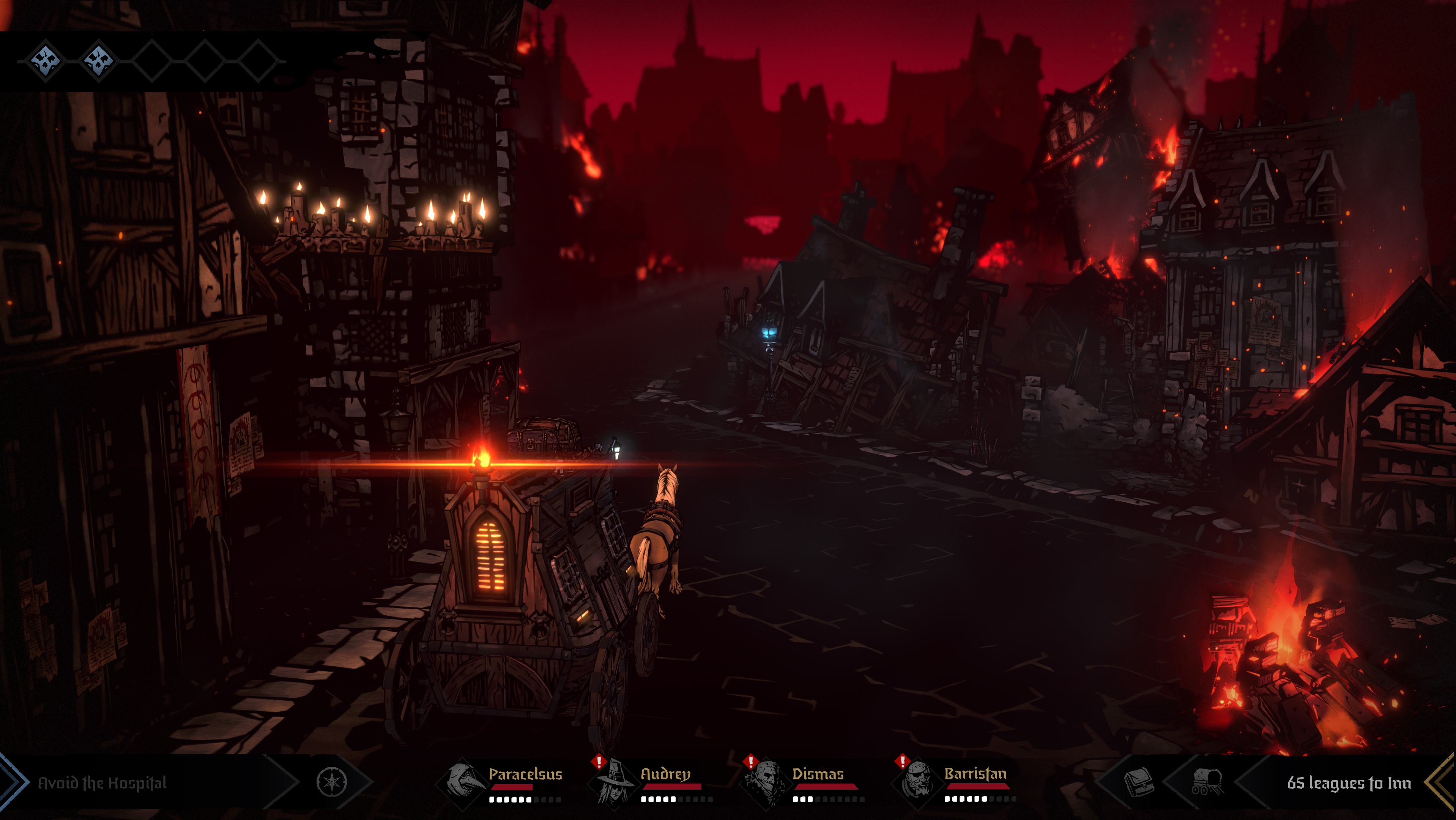
3. Ram stuff with your cart
Those breakable obstacles in the road? Run right the hell over them. They don't damage your party or contribute stress. But they do a chance of dropping combat and inn items, primarily food. Free stuff, in this end-of-the-world economy? Take it.
Still, this isn't Mario Kart. The horse-drawn cart features a bit of a delay when driving. I've found it best to use the "auto-forward" command by double-tapping W, and making small steering adjustments with individual A/D key taps.
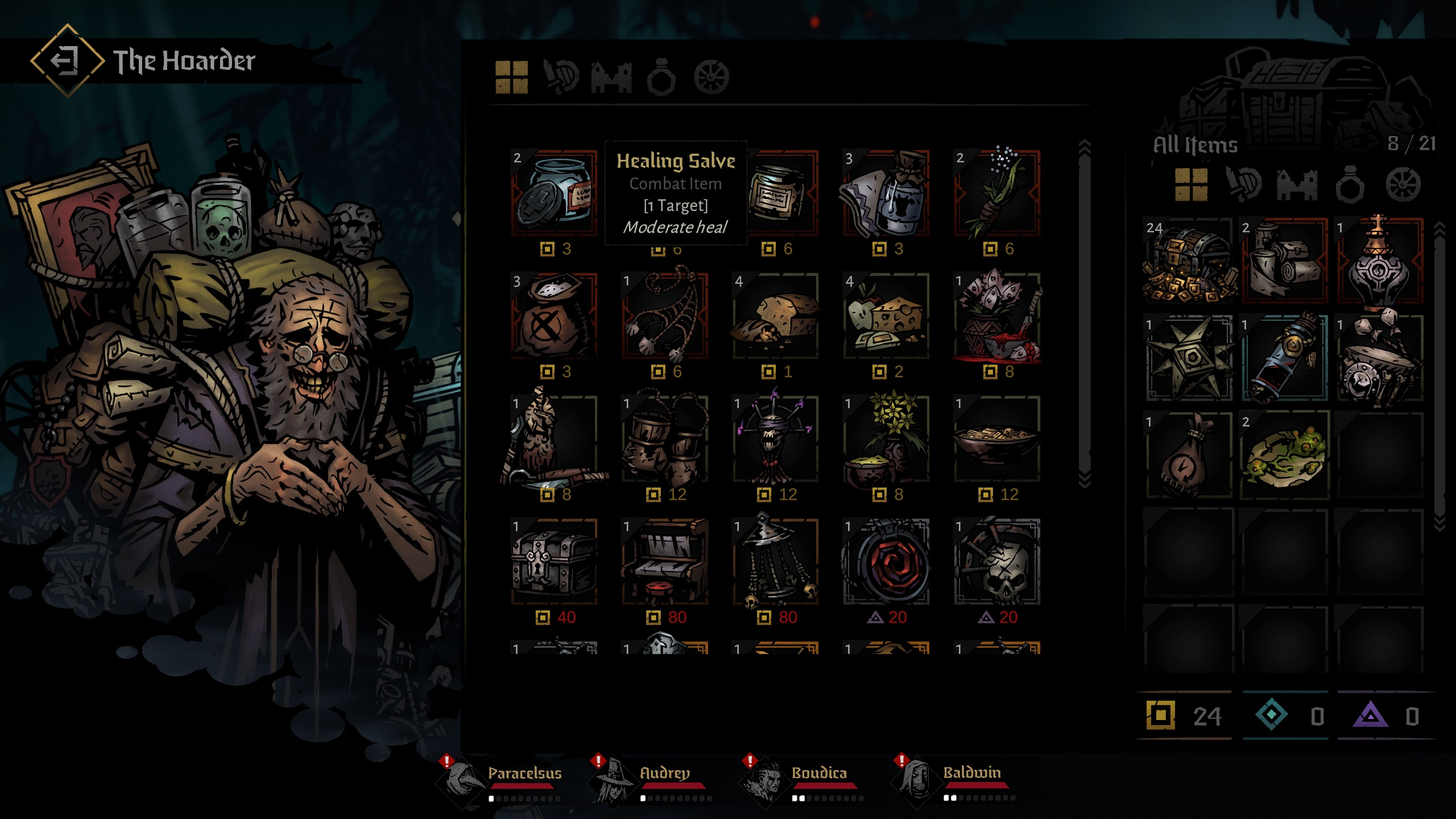
4. Use your damn items! (And keep 1 inventory slot open.)
There’s no need to be precious with consumables in Darkest Dungeon 2. If anything I found it easy to focus on my heroes’ abilities and forget to use combat items. It’s a free action to use an item in combat: your hero can still move or use an ability after using an item like healing salve or laudanum. I found Darkest Dungeon 2 to be very generous with combat consumables and even more so with items only usable at inns, so it absolutely pays to use them with abandon.
Also, carriage space is probably going to be a premium for you throughout your run. I recommend keeping at least one open inventory slot at all times, which will allow you to receive items from the aforementioned road debris. If your inventory is full, you won't receive these free items.
The desperate theme of Darkest Dungeon 2 will make you want to horde stuff like food and money, but as the narrator reminds at several points, that stuff is meaningless if you don't use it.
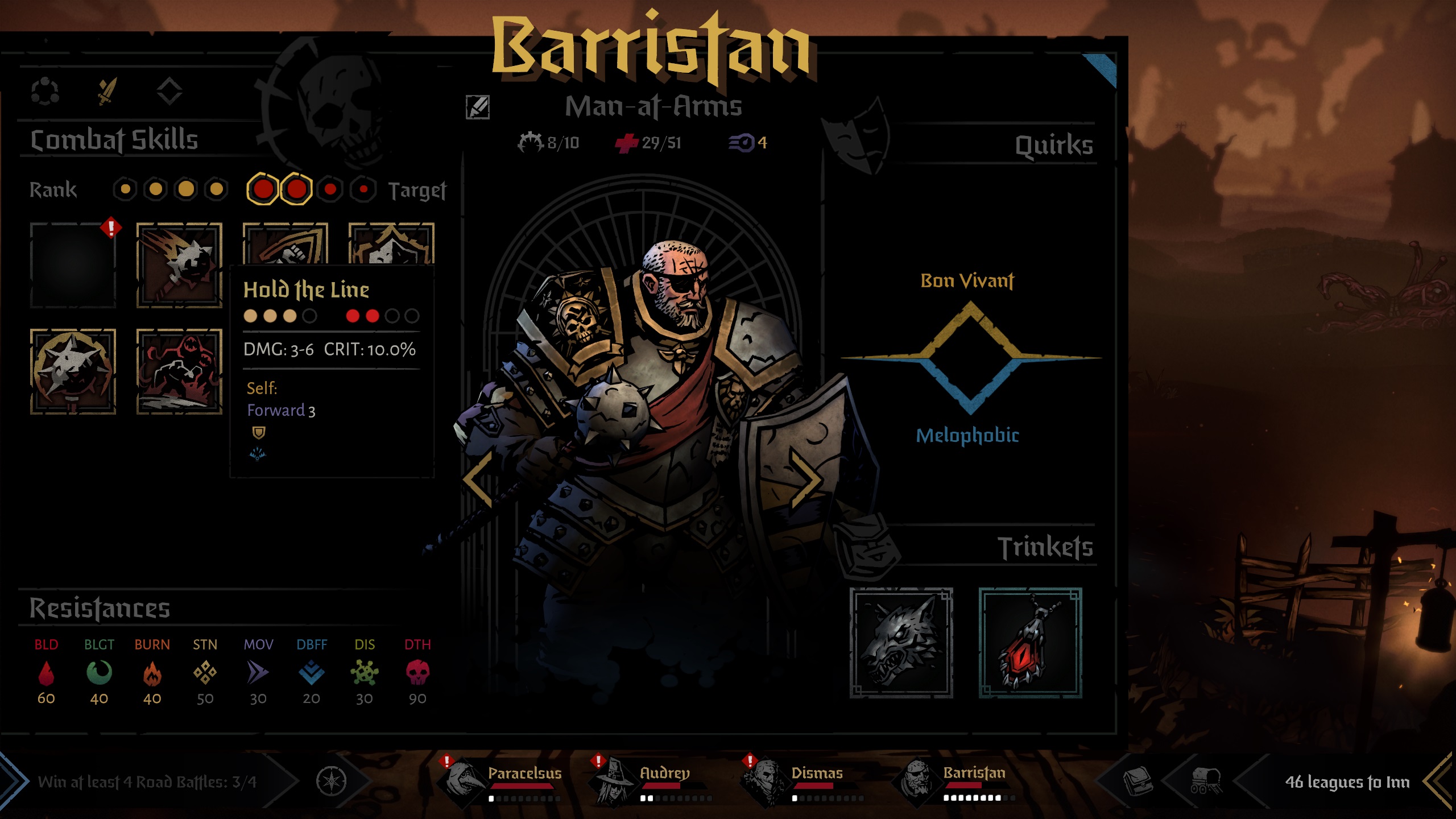
5. Understand positioning and build a complimentary party
The four-character lineup is a Darkest Dungeon signature. Abilities and their potential effects rely both on your character’s position, as well as the enemy’s. In the above screenshot, you can see I have the Man-at-Arms’ “Hold the Line” ability selected. The yellow dots indicate where he has to be positioned to activate this ability, and the red dots indicate the locations in the enemy lineup he can target. Above the abilities, the respective size of the pips indicate my Man-at-Arms’ overall strength. You can see most of his abilities require him to be in the front three rows of my party, and they largely affect the front two rows of the enemy line.
Of the starting characters, Man-at-Arms belongs in one of your front two rows, the Highwayman in the other one, while the Grave Robber and Plague Doctor should form your back line. Your party should ideally have a tank, a healer, two damage dealers, and the ability to target each enemy position. Don’t be like me and try to swap in the Hellion for the Grave Robber without changing anything else. That party was unable to target the backline well, and my run ended pretty quickly.
Another trick is noticing that some characters, like the Highwayman, have a strong opening ability that moves them in the lineup. Leading with Dismas' Duelist Advance activates counter-attacks when he's next targeted, and moves him forward one space. So setting him back to third or even fourth rank as a starting position is a valid strategy.

6. More DoTs, more DoTs!
Direct damage abilities have their place in Darkest Dungeon 2, but I found damage over time effects like burn, bleed, and blight to be essential for its hardest fights. DoT effects stack as well, meaning you can tag a high priority enemy with multiple tokens of each to maximise damage. Graverobber and Plague Doctor both start with blight abilities, and the Highwayman has a bleed attack that unlocks very early in his progression.
DoTs (which trigger at the beginning of an enemy's turn) also help KO tough enemies who've triggered Death's Door, the down-but-not-out condition.

7. Upgrade the Plague Doctor's Ounce of Prevention ability
Character progression in Darkest Dungeon is shockingly simple, relative to other RPGs. Your heroes do not gain XP and level up. Instead, certain combat encounters offer “Mastery Points,” a shared resource that you spend at Inns. Each hero’s abilities can only be upgraded once per run, increasing its sheer numerical effectiveness and offering bonus effects. I found Mastery Point upgrades to be much more transformative and essential to a successful run than the equippable trinkets, and as such recommend prioritizing Resistance Encounters on your map to earn them.
With stress being the game's biggest foe, I had a lot of success using the guaranteed Mastery Point at the beginning of each run to upgrade the Plague Doctor’s “Ounce of Prevention” ability. In its upgraded state, Ounce of Prevention will heal a point of stress and buff the defences of your entire party at once, greatly expanding your stress management options.
Be careful about investing several Mastery Points into the same character—if they die, their upgraded abilities die with them. Dead characters are replaced with a fresh adventurer at the next inn, if you can make it there.

8. Don’t get loathsome
Darkest Dungeon 2 uses two meters to track the overall state of your game, similar to Demons’ Souls’ World Tendency system. The torch on your cart is a familiar sight from the first Darkest Dungeon. Its strength is measured on a scale of zero to one hundred, beginning at maximum after every inn and ticking down as you progress forward. At its brightest, the torch confers combat bonuses to your party, with the balance changing and ultimately tipping in favor of your enemies as it dims. The rate at which the torch fizzles out is directly tied to the other meter: Loathing. Loathing increases when you reach the inn at the end of each world, and is kept at bay by clearing enemy combat challenges marked on the map, such as Resistance, Lair, and Cultist encounters. Additionally, completing all three rounds of the final Guardian challenge of each map will significantly lower Loathing. At high Loathing and dimmer torch, combat takes a sharp spike in difficulty. I had one of my first solid runs tanked by having too high a Loathing score going into a difficult area.
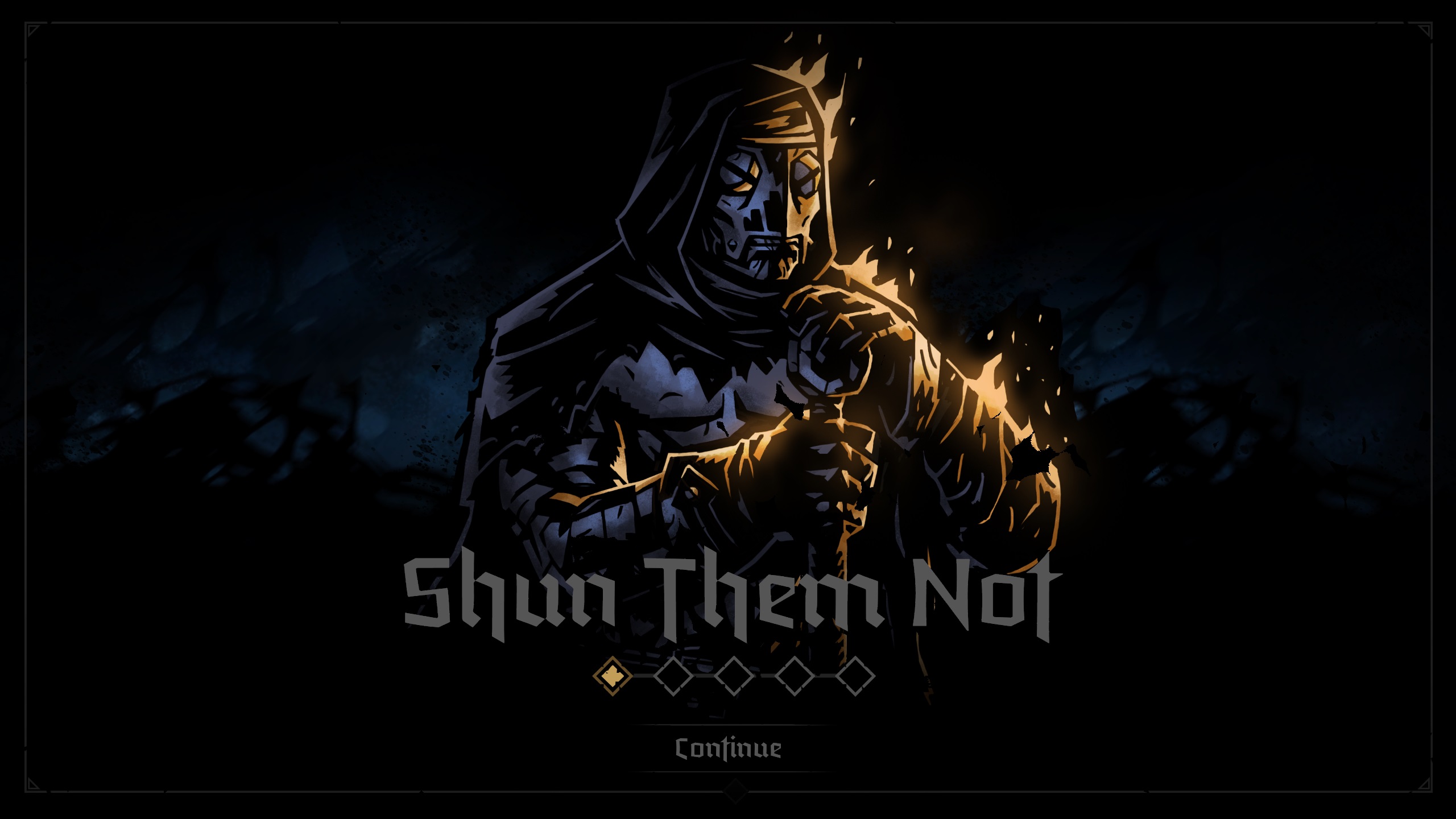
9. Prioritize Shrines of Reflection
One reward that stays persistent in-between runs is new abilities for your heroes, unlocked at Shrines of Reflection. The shrines appear as a bell icon on your map, and prompt you to choose a member of your party to get the new ability, as well as some backstory narration. Most of the five sequences of each hero’s story are passive, but at least one will be a playable combat puzzle where it is possible to fail, with some being harder or more obtuse than others.
You'll want to unlock these abilities in order to give yourself more combat flexibility. In my own playtime, I found Highwayman and Grave Robber’s early unlockable abilities, “Open Vein” and “Dead of Night,” very useful.
Ted has been thinking about PC games and bothering anyone who would listen with his thoughts on them ever since he booted up his sister's copy of Neverwinter Nights on the family computer. He is obsessed with all things CRPG and CRPG-adjacent, but has also covered esports, modding, and rare game collecting. When he's not playing or writing about games, you can find Ted lifting weights on his back porch.

